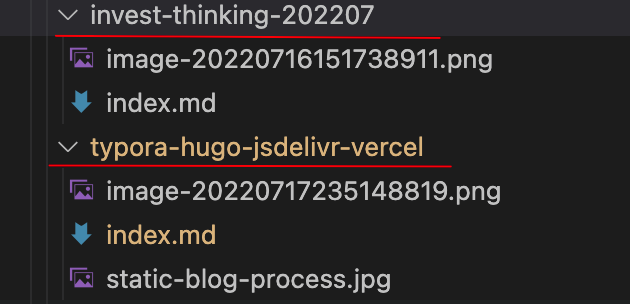使用hugo+jsdelivr+typora+vercel打造静态博客的步骤
Overview
使用hugo+github+jsdelivr+typora+vercel打造静态博客的步骤与关键
步骤说明
此文的阅读对象主要是有开发背景的同学,内容是讲述静态博客的打造思路。
- Typora - markdown格式博文的写作工具,方便我们日常编写博客文章。
- Github - markdown格式博客文章 + image文件的仓库,主要用来存储编写的博客,通常需要配合git版本控制工具使用。
- Hugo - 静态网站的“编译”工厂,输入原料是markdown格式的博客文章+静态image文件,输出则是静态的html博客文件。
- Jsdelivr - 免费的CDN加速服务提供商,可以给我们的静态博客的图片、视频进行加速。
- vercel - 免费的静态网站编译、托管工具,提供一站式的网站托管服务。

静态网站的痛点有哪些?
图片备份与稳定加速
静态网站的痛点是图片的托管,要兼顾稳定性与备份的需要。出于备份的需要,我们 要求图片必须保存在github中;稳定性呢,则要么使用付费的第三方图片存储与加速服务(比如阿里云,七牛云),要么使用免费但稳定的jsdelivr图片加速服务,它可以与github代码库无缝集成,任何代码库中的图片,均可以使用如下格式直接进行加速访问:
1https://cdn.jsdelivr.net/gh/{GITHUB用户名}/{GITHUB代码库名}/图片在仓库中的相对路径.图片后缀
而hugo正好有一项pageBundles功能,其核心是将每一篇文章的markdown文件与图片组织在一个目录下,其中目录名编译后对应文章名,markdown文件名则统一为index.md。比如我的两篇文章组织形式如下:

开启pageBundles的步骤
-
文章组织形式按上面图片类似的格式进行 组织。
-
每篇博文中(index.md)指定:
usePageBundles: true1--- 2title: '使用hugo+jsdelivr+typora+vercel打造静态博客的步骤' 3description: '使用hugo+jsdelivr+typora+vercel打造静态博客的步骤' 4summary: "使用hugo+jsdelivr+typora+vercel打造静态博客的步骤" 5date: '2022-07-17' 6author: '飞天' 7usePageBundles: true 8toc: true 9--- -
主题中负责图片渲染src的地方稍做修改:
比如我就在themes/hugo-clarity/layouts/partials/figure.html中修改了渲染的逻辑
1{{/* 2 If Hugo has been able to access the image, it's loaded at .image, and we have 3 access to additional attributes. 4 5 If Hugo hasn't been able to access the image, it's loaded at .file, with only 6 its path available. 7 8 We set the Hugo variables to strings to allow for logical operations and 9 replacements. 10*/}} 11 12{{- $file := .file -}} 13{{- $image := .image -}} 14{{- $diskPath := .diskPath -}} 15{{- $webPath := .webPath -}} 16{{- $alt := .alt -}} 17{{- $cap := .cap -}} 18{{- $classes := .classes -}} 19{{- $bundle := .bundle -}} 20 21{{- $fileWeb := .file -}} 22{{- if eq $bundle true -}} 23 {{ $fileWeb = path.Join $webPath $file }} 24 {{ if in $classes "image_svg" }} 25 {{ if strings.HasPrefix $file "http" }} 26 {{ $fileWeb = $file }} 27 {{- end -}} 28 {{- end -}} 29{{- end -}} 30 31<figure> 32 <picture> 33 34 {{/* Generate alternate image format tags. */}} 35 {{- with $file -}} 36 {{ $name := replace $file (path.Ext $file) "" }} 37 {{ $ext := slice "avif" "webp" "jxl" }} 38 {{- range $ext -}} 39 {{ $item := printf "%s" . | printf "%s%s" "." | printf "%s%s" $name | printf "%s" }} 40 {{ $itemDisk := path.Join $diskPath $item }} 41 {{ $itemWeb := path.Join $webPath $item }} 42 {{- if fileExists $itemDisk -}} 43 <source srcset="{{ $itemWeb }}" type="image/{{ . }}"> 44 {{- end -}} 45 {{- end -}} 46 {{- end -}} 47 48 {{/* Render image and attributes. */}} 49 <img 50 loading="lazy" 51 decoding="async" 52 alt="{{ htmlEscape $alt }}" 53 {{ with $image }} 54 class="{{ $classes }} image_processed" 55 width="{{ .Width }}" 56 height="{{ .Height }}" 57 {{ if eq $bundle true }} 58 src="https://cdn.jsdelivr.net/gh/tfnick/blog/content{{ .RelPermalink }}" 59 {{ else }} 60 src="{{ .RelPermalink }}" 61 {{ end }} 62 {{ else }} 63 class="{{ $classes }} image_unprocessed" 64 src="{{ $fileWeb }}" 65 {{ end }} 66 {{ with $cap }} 67 title="{{ htmlEscape $cap }}" 68 {{ end }} 69 /> 70 71 {{/* Provide caption based on image title, if it is set. */}} 72 {{- with $cap -}} 73 {{- if not (eq $cap " ") -}} 74 <figcaption class="{{ replace $classes "image" "caption" }}">{{ $cap | safeHTML }}</figcaption> 75 {{- end -}} 76 {{- end -}} 77 78 </picture> 79</figure>其中即是修改之处:
1 {{ if eq $bundle true }} 2 src="https://cdn.jsdelivr.net/gh/tfnick/blog/content{{ .RelPermalink }}" 3 {{ else }} 4 src="{{ .RelPermalink }}" 5 {{ end }}
图片插入的便捷性
图片的插入便捷性通过typora来解决,包括:
- 截图插入,需要能保证图片能自动存储到index.md所在目录
- 如果引用(复制)的第三方网站的文章与图片,需要保证图片能自动保存到计算机本地index.md所在的目录
- 插入本地的图片,也需要能保证可以自动复制图片到index.md所在目录
所幸的是,typora只需要经过简单的配置即可达到上述要求。
注此方案下,不再需要使用pigGo等图片上传工具将 图片上传到jsdelivr,更进一步的简化了博文的编写。
vercel网站托管
vercel与github配置好之后,其可以指定hugo的版本,自动编译html并发布到vercel的容器中,配置好自有域名之后,基本上可谓一劳永逸。
优势
一个静态博客配置完成之后,通过typora编写文章,通过git提交到github,后续的发布全部由vercel自动完成,写作者不再需要关注,可以真正享受写文章的乐趣,NICE~